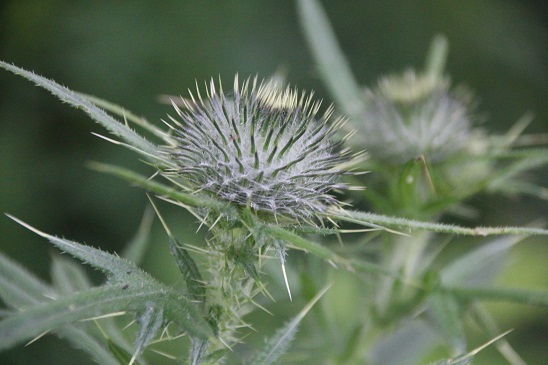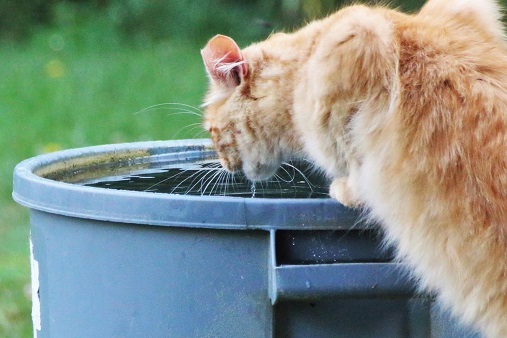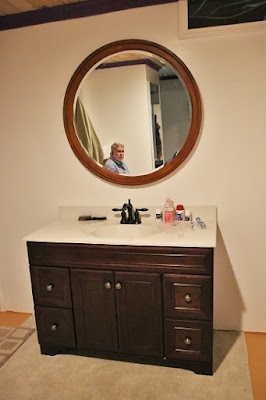Well!
All I
can say is I really messed up last week's letter blog!
For
starters, I printed them with the wrong date at the top. I use a saved format,
keeping the date at the top and changing just the day, and month, as required.
I guess it was just a matter of time until I messed it up.
And, lastly,
I missed a picture! I was talking about things yet to bloom, showed you bergamot,
but didn't show you the bull thistle!
Oh, the
difference a few days can make!
...and is also called Wild Carrot because the root smells like carrots. It
got its name because of a legend that Queen Anne pricked her finger and a drop
of blood landed on the lace she was sewing.
Oftentimes
this wildflower will have a single purple, almost black, flower at its center.
But we
call it a weed and chop it down.
The
teasel will soon be blooming.
This wildflower grows tall, way over my head. The
leaves grow together around the stem and form cups that hold water and dead
insects. I wonder if this is something that benefits the plant or just
something that happens.
I did. I
discovered that teasel has a rich history but can't find anything that speaks
specifically to that.
This
dragonfly was easy to identify because of his coloring. He's a Spangled
Skimmer.
"What,
Peg, no close-up?"
Nope.
Not this time. The Bouncing Bet was down an embankment on our dirt road and I
couldn't get to it, so this is all you get — for now.
Oh my gosh! Look at the chokecherries!
They will continue to ripen until they are a dark red-purple in another month.
These guys are almost all seed but you can turn them into wine and/or jelly.
I found
a wildflower I'd never seen before. When the flowers bend down like this they call
them nodding heads. So I had to either get down on the ground and shoot up, or
pick one and turn it over. Guess which I did.
And so
the plant got its name.
It's not
the plant that has magical powers to soothe the savage beast, but rather it
repels gnats and other annoying insects, which in turn can make an animal
easier to handle.
Speaking
of pests, here's a stinkbug for you. These are sometimes called shieldbugs too.
"What
is it?" you wonder.
He's an
aphid. A Woolly Aphid. The fluff is actually a wax-like substance they secrete
to make them taste bad to critters that might want to eat them.
I know,
right! I wondered that myself. Turns out there are a few things that will eat
them; ladybugs, hoverflies, and parasitic wasps are a few.
These
are Black bean aphids, having lunch.
I know,
I know! More than you wanted to know.
The
Chicory is blooming too. Did you know that each flower only lasts for a day?
Chicory
roots can be roasted and ground as a coffee substitute or additive.
Have you
ever wondered what they did before the advent of pesticides?
Yeah! Me
too!
"When
I was a little girl, we picked apples in an orchard where the people didn't
care if they got any apples or not, so I'm pretty sure they weren't
sprayed," Momma said when I broached the subject with her.
"And
they weren't wormy or you ate the apples anyway?"
"So
how did they not get wormy?"
"I
don't know."
And the
mystery is still a mystery.
Bittersweet
Nightshade.
"I
know this one!" you say. "It's poisonous."
Yes, it
is, but not nearly so much as you might think. Belladonna is the one called
Deadly Nightshade.
This
one, this Bittersweet Nightshade has its place in herbal medicine. But my
advice is this; unless you know what you're doing — leave it alone.
This is
Rascal. Drinking out of the rain barrel. All of our cats drink out of the rain
barrel.
Then the cat draws its tongue back up, forming a
column of liquid, which it bites off and gets a nice drink of water — and he
doesn't get his chin wet.
We've
got the vanities in our master bath. That's right, you heard me! Vanities!
Plural!
We were
only going to get one vanity right now, but we found a deal on these two. They
were a close-out so if we didn't buy them both, there was no guarantee we would
ever be able to get a matching one in the future.
Mike's
is a four-foot vanity and we put a mirror that we already owned above it until
we can afford to buy the medicine cabinets.
"Peg?
You have a drawer under your sink. How did you do that?"
Good
eye! And I'm so glad you asked!
Speaking
of Mike, someone got his mower stuck — again.
He did.
On a
recent walk-about with the girls, Itsy and Ginger, and my entourage, we
happened on this little guy up by the upper barn. I stopped in my tracks. The
girls hadn't seen it yet.
and
the cats had seen him too.
We stood still and quiet and watched him for
probably four or five minutes before he bounded into the weeds.
I still
can't believe the dogs didn't bark.
He is,
of course, a Yellow Finch.
This guy
is a Yellow-Collared Scape Moth. Despite having yellow in its name, they have
an orange collar. I couldn't get a picture of his topside cause he flew off.
This
guy's a skipper, you can tell because of the big eyes, but I don't know which
one he is. He's on Wild Basil
This is a little iridescent bee on
white sweet clover.
My
birthday is coming up next month and I wanted a study Bible. Mike, bless his
heart, didn't wait for my birthday and bought me one. I'm not very good at
finding the books in the Bible yet so tabs are a must for me.
I flipped to Nehemiah and you can clearly see the
tab is placed smack dab between the dotted lines!
So what's wrong! I flipped
back and forth at least four, maybe six times before I figured it out.
Do you
see it?
I was
supposed to line it up with the arrow and not the dotted line.
Even though
the pages are thin, they are tough. I gently peeled the tab off and
repositioned it.
Let's finish
up with an evening, not quite sunset, photo.
And with
that, let's call this one done!








































No comments:
Post a Comment